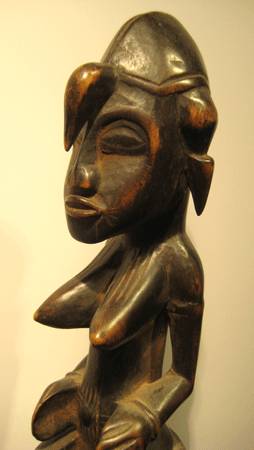Senufo Staff, 19th Century CE - 20th Century CE
Wood
2.75 x 60
LSO.242
This extremely flamboyant anthropomorphic staff was made by the Senufo people of the Ivory Coast and Mali. The body of the piece, which comprises about two thirds of total length,...
This extremely flamboyant anthropomorphic staff was made by the Senufo people of the Ivory Coast and Mali. The body of the piece, which comprises about two thirds of total length, is slender and plain, with a pointed tip. There are two small bird figures attached to the shaft, one on either side. The apex is marked with a beveled pedestal, which forms the base for a large bird figure, standing erect, and bearing a final pedestal on its head. This supports a narrow stem, surmounted by a female figure sitting on a four-legged stool. She is carved in the traditionally Senufo style, with a high, crested coiffure, a central frontal diadem, long ear flashes and a queue down the nape of the neck. She has armlets and bracelets, in addition to stellate scarring around the navel, hatched lines beside the eyes and the mouth, and long vertical lines on the (very pronounced) breasts.
The Senufo group, based in the Ivory Coast and Mali area, migrated to their current location from the north during the 15th and 16th centuries AD. Their economy is primarily agricultural and settled. At the heart of Senufo society is a patriarchal group of elders known as the Poro, which is responsible for many religious and secular functions to do with the running of the tribal group. Smaller-scale magical issues, however, are usually dealt with by diviners or soothsayers (sandoo). Figures representing ancestors and spirits are used centrally and in individual homes; Senufo carvers are exceptionally talented producers of religious and prestige art.
The aforementioned Poro society is the single most important organ in Senufo culture. The route through the various ranks is a major preoccupation for most male members of the society, although there were other routes for women to follow (notably divining and soothsaying). The regalia of the Poro society vary from rank to rank, but staffs and staves are a fundamental part of status signaling in all parts of Africa, and the Senufo are no exception. In the Senufo, staffs with this sort of adornment were also awarded to productive farmers. The iconography is hyper-variable, but certain aspects stand out. The appearance of female personages is usually attributable to a preoccupation with fertility, as abdomen and breasts are usually accentuated. If a farmer's staff, the significance of fertility (i.e. of crops) is clear. The presence of a chair or stool is a marker of high social status. The current piece is presumed to be secular in that it does not seem to be linked to any known Senufo religious tradition, although it may refer to an ancestress or other important person from Senufo history.
The birds are often found in Senufo art, and are likely to represent hornbills (Setien, or Porpianong). Large versions are associated with fertility and dance rituals, while smaller ones are good-luck charms. Hornbills are noble birds; they mate for life, they share equally in the raising of their young who they protect by spreading their wings. They are depicted in their erect, protective stance. The patination and condition of the piece implies a long life and extensive usage by the original owner/s.
This is a significant and attractive piece of African art.
The Senufo group, based in the Ivory Coast and Mali area, migrated to their current location from the north during the 15th and 16th centuries AD. Their economy is primarily agricultural and settled. At the heart of Senufo society is a patriarchal group of elders known as the Poro, which is responsible for many religious and secular functions to do with the running of the tribal group. Smaller-scale magical issues, however, are usually dealt with by diviners or soothsayers (sandoo). Figures representing ancestors and spirits are used centrally and in individual homes; Senufo carvers are exceptionally talented producers of religious and prestige art.
The aforementioned Poro society is the single most important organ in Senufo culture. The route through the various ranks is a major preoccupation for most male members of the society, although there were other routes for women to follow (notably divining and soothsaying). The regalia of the Poro society vary from rank to rank, but staffs and staves are a fundamental part of status signaling in all parts of Africa, and the Senufo are no exception. In the Senufo, staffs with this sort of adornment were also awarded to productive farmers. The iconography is hyper-variable, but certain aspects stand out. The appearance of female personages is usually attributable to a preoccupation with fertility, as abdomen and breasts are usually accentuated. If a farmer's staff, the significance of fertility (i.e. of crops) is clear. The presence of a chair or stool is a marker of high social status. The current piece is presumed to be secular in that it does not seem to be linked to any known Senufo religious tradition, although it may refer to an ancestress or other important person from Senufo history.
The birds are often found in Senufo art, and are likely to represent hornbills (Setien, or Porpianong). Large versions are associated with fertility and dance rituals, while smaller ones are good-luck charms. Hornbills are noble birds; they mate for life, they share equally in the raising of their young who they protect by spreading their wings. They are depicted in their erect, protective stance. The patination and condition of the piece implies a long life and extensive usage by the original owner/s.
This is a significant and attractive piece of African art.
